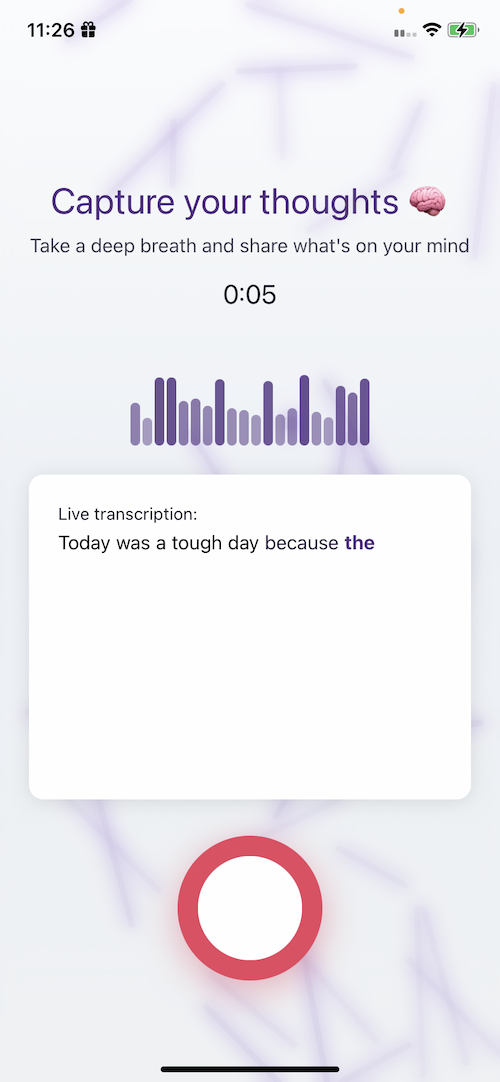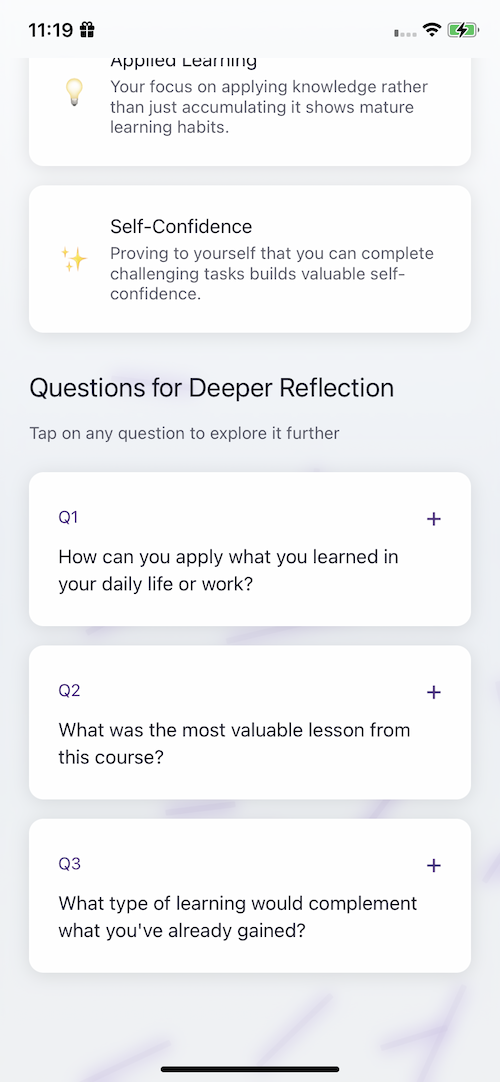Voice Journaling Revolution: Why Speaking Your Thoughts Beats Writing Them
- 8 minsThe Traditional Journaling Paradox
I’ve always been told that writing by hand is the best way to journal. The idea is that forming letters on paper creates some special cognitive pathway that helps you think more clearly and organize your thoughts better. That’s why every journaling app out there is built around writing—they assume that to really reflect on your life, you need to sit down and carefully put your feelings into words on paper.
But here’s what I’ve been wondering lately: what if that’s not true for everyone? What if some of us think better when we talk rather than when we write? What if we could flip the whole journaling thing on its head and use our voice instead?
My Personal Discovery
This all started with a simple realization I had about myself: I’m way better at expressing my emotions and working through complex thoughts when I’m talking out loud than when I’m trying to write them down. It’s like there’s this direct line from my brain to my mouth that just works better than the one to my hands.
I started noticing this when I’d try to journal about something difficult that happened during the day. I’d sit there with a pen and paper (or more often, my phone), and I’d struggle to get the words out. But then I’d call a friend and suddenly I’m explaining the whole situation perfectly, with all the nuance and emotion that I couldn’t capture in writing.
The thing is, writing has these built-in barriers that I never really thought about before. You have to think about spelling, grammar, sentence structure—all this stuff that has nothing to do with what you’re actually feeling. It’s like trying to have a deep conversation while also solving a puzzle. Sometimes the puzzle-solving part takes over, and you lose the emotional thread you were trying to follow.
Why Voice is So Much Richer
Here’s the thing about voice that I find fascinating: when you talk, you’re not just saying words. You’re communicating through your tone, your rhythm, how fast or slow you’re speaking, the little pauses and stutters—all of this stuff that writing completely strips away.
I’ve noticed that when I’m talking about something I’m excited about, my voice gets higher and I talk faster. When I’m struggling with something, I slow down and my voice gets quieter. When I’m not sure about something, I’ll pause or say “um” a lot. These are all clues about what’s really going on in my head that I would never capture if I was just writing.
And here’s something else I’ve realized: those little mistakes and corrections we make when we’re talking? The “um”s and “uh”s and mid-sentence corrections? Those actually tell you something about what’s happening in your brain. When I’m writing, I edit all that stuff out, but when I’m talking, it’s all there—the raw, unfiltered version of my thinking process.
The Beauty of Unfiltered Thoughts
One of the things I love most about voice journaling is that it captures your thoughts exactly as they happen. When you’re talking, you don’t have time to think “should I say this?” or “how should I phrase this?”—you just speak. And what comes out is often the most honest version of what you’re thinking.
I’ve found that when I try to write about something, I end up editing myself before I even get the words down. I’ll think “that sounds stupid” or “I should rephrase that” and end up with something that’s not really how I feel. But when I’m talking, I can’t do that. The words just come out, and they’re usually more honest and more revealing than anything I could write.
And here’s the cool part: when you do try to correct yourself while talking, the original thought is still there in the recording. It’s like having a complete picture of your thinking process, including all the detours and corrections. This has been incredibly valuable for me—I can see patterns in how I think that I never would have noticed if I was just reading my written journal entries.
Building ThinkAloud: My Solution
After months of thinking about this problem, I decided to build something that would let me journal the way I actually think—through voice. That’s how ThinkAloud was born.
The idea is simple: you press a button and start talking. As you speak, your words get transcribed in real-time, so you can see your thoughts materialize on screen. But it’s not just a voice recorder—the app actually analyzes what you’re saying and asks you questions to help you dig deeper into your thoughts.
I’ve been working on this for a while now, learning about speech recognition technology and how to make sense of the patterns in our speech. It’s been a fascinating journey, and I’m excited about how it’s turning out.


Here’s what the app looks like—you can see the real-time transcription happening as you speak
Why Voice Journaling Works Better (For Me)
After using both methods for a while, I’ve noticed some clear differences between voice and written journaling. Here’s what I’ve found:
The Natural Flow
When I’m talking, my thoughts just flow. There’s no stopping to think about spelling or grammar or how to structure a sentence. It’s like having a conversation with myself, and the words come out exactly as I’m thinking them.
Capturing the Full Picture
Writing only captures the words, but voice captures so much more. I can hear in my recordings when I’m excited about something (my voice gets higher and faster), when I’m struggling (I slow down and get quieter), and when I’m not sure about something (lots of pauses and “um”s). This gives me a much richer picture of what was really going on in my head.
No Self-Editing
This is a big one for me. When I’m writing, I’m constantly editing myself—”that sounds stupid,” “I should rephrase that,” “that’s not quite right.” But when I’m talking, I can’t do that. What comes out is what I’m actually thinking, not what I think I should be thinking.
Speed and Efficiency
I can capture a day’s worth of thoughts in about 10 minutes of talking. If I tried to write all that down, it would take me an hour or more. Plus, I’d probably give up halfway through because writing is just more work for me.
What ThinkAloud Actually Does
So here’s how the app works under the hood:
Real-Time Transcription: As you’re talking, your words appear on screen almost instantly. It’s pretty magical to watch your thoughts materialize as you speak them.
Smart Analysis: The app doesn’t just transcribe—it actually tries to understand what you’re saying. It looks for patterns in your speech, emotional themes, and topics that come up frequently.
Guided Questions: Based on what you’ve said, it asks you questions to help you think deeper about certain topics. Like if you mention feeling stressed about work, it might ask “What specifically about work is causing this stress?” or “When did you first notice this feeling?”
I’m still working on making this part better, but it’s already been really helpful for me. Sometimes the questions it asks make me realize things I hadn’t thought about before.
Why This Matters
I think the reason this is so important is that we’ve been assuming everyone thinks the same way. We’ve built all these journaling tools around writing, but what if some of us just aren’t wired that way?
I know plenty of people who are amazing writers and love journaling with pen and paper. But I also know people like me who think better when they’re talking. We shouldn’t have to force ourselves into a writing mold just because that’s what’s available.
What I’ve Learned
Building ThinkAloud has taught me a few things:
People are different: What works for one person might not work for another, and that’s okay.
Technology can adapt to us: Instead of us adapting to technology, we can build tools that work the way we naturally think.
Voice is powerful: There’s something really special about capturing our thoughts exactly as they happen, without the filter of writing.
Wrapping Up
I’m not saying voice journaling is better than writing—I’m saying it’s different, and for some of us, it might be exactly what we need. ThinkAloud is my attempt to give people like me a way to journal that actually works with how our brains are wired.
If you’ve ever struggled with traditional journaling or felt like you couldn’t quite capture your thoughts in writing, maybe give voice a try. You might be surprised by how much more natural it feels.
This is just my experience and what I’ve learned along the way. I’d love to hear from others who’ve tried voice journaling or who have similar struggles with written journaling.
